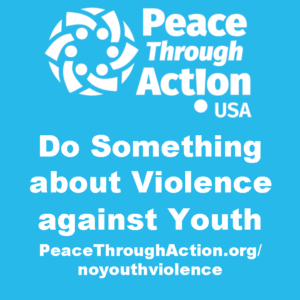
What is violence against youth?
Violence against youth refers to any form of violence involving unrelated individuals aged between 10-29 years. This includes a wide range of acts, from bullying to gang-related violence, and sexual assault.[1]
Violence against youth can be categorised in several ways. The first classification pertains to the type of violence used, which can be physical, psychological, or sexual. The second classification is based on the type of victim-perpetrator relationship, which can be self-directed, interpersonal, or collective.[2]
[1] World Health Organization. (2022). Youth Violence. Retrieved 30 November 2023, from https://apps.who.int/violence-info/youth-violence
[2] Centre for Justice and Crime Prevention. (n.d.). Youth Violence. Retrieved 30 November 2023, from https://www.saferspaces.org.za/understand/entry/youth-violence
How widespread is violence against youth in the United States?
Violence against youth is common in all its forms:
- 1 in 5 high school students reported being bullied on school property in 2016[3]
- An average of 12 young people die by homicide every day[4]
- An average of 1,642 young people are treated for physical assault injuries every day[5]
Disparities between groups:
- In 2016, the rate of youth homicides was six times greater for males compared to females[6]
- Homicide stands as the primary cause of death for African-American youth, the second leading cause for Hispanic youth, the third leading cause for American Indian/Alaska Native youth, and the fourth leading cause among White and Asian/Pacific Islander youth[7]
- According to studies, individuals who identify as LGBTQ+ face a heightened risk of violence compared to peers who do not identify as LGBTQ+[8]
[3] U.S. government. (s.d.). Federal Data. Retrieved 30 November 2023, from https://youth.gov/youth-topics/violence-prevention/federal-data
[4] Chicago Center for Youth Violence Prevention. (2018). About Youth & Community Violence. Retrieved 30 November 2023, from https://voices.uchicago.edu/ccyvp/about/about-youth-violence/
[5] Ibid.
[6] U.S. government. (s.d.). Federal Data. Retrieved 30 November 2023, from https://youth.gov/youth-topics/violence-prevention/federal-datA
[7] Ibid.
[8] Levine, E. C., & Button, D. M. (2022). Interpersonal Violence Among Heterosexual and Sexual Minority Youth: Descriptive Findings From the 2017 Youth Risk Behavior Surveillance System. Journal of Interpersonal Violence, 37(13-14), NP12564-NP12583. https://doi.org/10.1177/08862605211001351
What culture changes and public policies are necessary for preventing violence against youth?
Long-term solutions for preventing and reducing violence against youth involve a holistic approach that considers community, environmental, and policy-level elements, just like all public health challenges. However, in the United States, research shows that 86% of youth homicide victims are killed by firearm.[9] Some researchers therefore recommend gun restriction and gun safety policy.[10] According to the World Health Organization (WHO), there is a strong correlation between youth violence and economic inequalities. Therefore, the institution recognizes the importance of addressing wage disparities, improving access to jobs, enhancing social protection, promoting education, and fostering economic mobility.[11]
[9] Chicago Center for Youth Violence Prevention. (2018). About Youth & Community Violence. Retrieved 30 November 2023, from https://voices.uchicago.edu/ccyvp/about/about-youth-violence/
[10] Bottiani, J. H., Camacho, D. A., Lindstrom Johnson, S., & Bradshaw, C. P. (2021). Annual research review: youth firearm violence disparities in the United States and implications for prevention. Journal of child psychology and psychiatry, 62(5), 563-579.
[11] World Health Organization. (2022). Youth Violence. Retrieved 1 December 2023, from https://apps.who.int/violence-info/youth-violence
What practical solutions are effective for preventing violence against youth?
Many programs have been judged to be effective. These include preschool enrichment with family engagement and universal school-based programs, which improve the quality of education. Early childhood home visitation and parenting skills and family relationship programs promote a healthy family environment. Finally, mentoring programs and after-school programs are useful for connecting young people with caring adults and activities.[12] Learn more about these practical peaceful solutions in our Choose Peaceful Practices series of information pages.
[12] Centers for Disease Control and Prevention. (2023). Violence Prevention. Retrieved 1 December 2023, from https://www.cdc.gov/violenceprevention/youthviolence/fastfact.html
What can I do to prevent or stop violence against youth?
What adults can do:
- Build positive relationships—Encourage positive relationships by being supportive and caring.
- Encourage education—Support and encourage young people to stay engaged in school.
- Promote inclusivity—Encourage inclusivity and discourage bullying or exclusion.
- Be a positive role model—Demonstrate conflict resolution skills and model non-violent behavior.
What young people can do:
- Ask for help—Seek out trusted adults, acquaintances, or relatives with whom to discuss distressing circumstances.
- Build positive relationships—Connect with individuals who offer support and concern, engaging in open discussions with them regarding your emotions.
- If you’re in crisis—Call the National Suicide Prevention Lifeline at 1-800-273-8255.
- In case of emergency—If you are experiencing or witnessing an emergency, call 911 or try to get to a location where others can observe your distress and intervene.
What can I find statistics about violence against youth?
- For national-level statistics about violence against youth, go to US Department of Justice and Office of Juvenile Justice and Delinquency Prevention
- For state-level statistics about violence against youth, go to Centers for Disease Control and Prevention
Where else might I go to learn about violence against youth?
- United Nations Office on Drugs and Crime— In order to create inclusive and peaceful communities, UNODC actively engages youth in drug prevention, crime prevention, and justice system improvement.
- UNICEF—UNICEF combats violence against youth by working to provide safe and protective environments for children and teenagers, defending their rights, and implementing initiatives that support positive development, education, and mental health.
- Human Rights Watch—Human Rights Watch actively combats violence against youth by monitoring, disclosing, and speaking out against violations of human rights that affect young people.
- The National Institute for Criminal Justice Reform—NICJR aims at combating violence against youth by reducing incarceration, improving outcomes for system-involved youth, and strengthening organizations through technical assistance, research, and advocacy in juvenile justice and violence prevention.
Information Sheet-Do Something-Violence against Youth (PDF)
Author: Luna Marciano
Have a suggested improvement to this information sheet? Send it to inbox@peacethroughaction.org
Do Something Right Away to Increase Peace
Subscribe to our YouTube channel
Give money to support Peace Through Action’s mission delivery activities
Choose opportunities to take part in our #PeaceBeginsWithWe campaign
